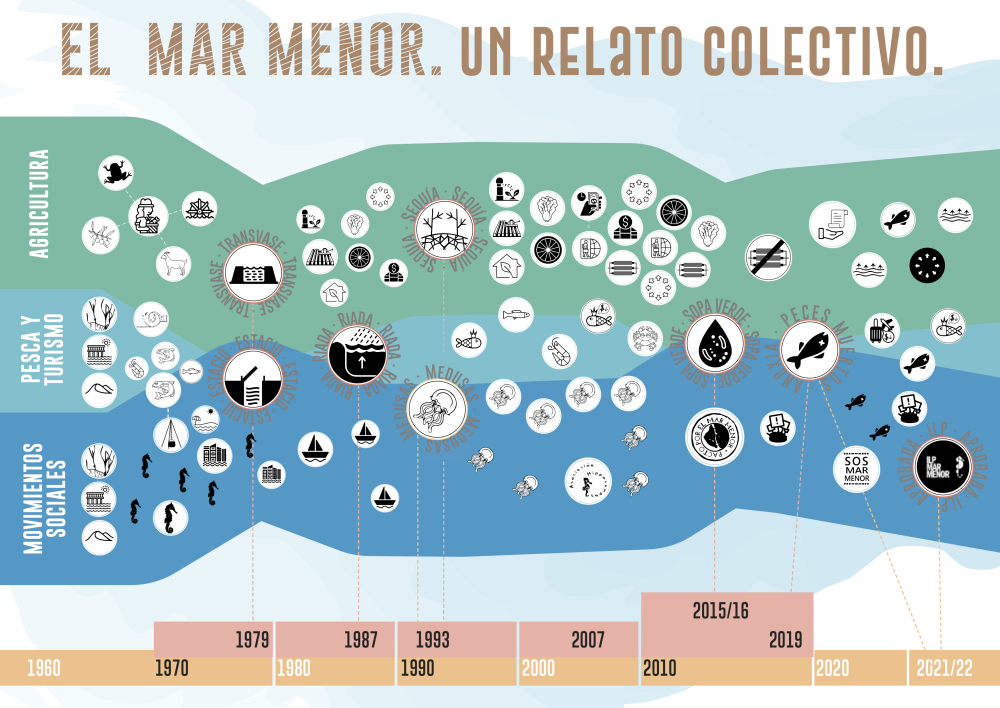From the land to the sea: A collective story on transformation in the Mar Menor
Currently at the core of their co-productive research process, Paula Zuluaga Guerra, NEWAVE Early Stage Researcher #7, and Dr. Violeta Cabello Villarejo, Postdoctoral Researcher at the Basque Centre for Climate Change (BC3), describe the scientific process that led to the first results of their work on the Mar Menor case.
The results include an engaging collective story that Paula and Violeta built with 30 locals of the Mar Menor Lagoon and the Campo de Cartegena, combined with an infographic and an audio story. All these outputs are available in our Resources section.
In the context of our doctoral thesis (in the case of the ESR #7, Paula Andrea Zuluaga Guerra) and post-doctoral project (Dr. Violeta Cabello Villarejo), we decided to join efforts and build an action-research process directed towards collective construction of knowledge as a means for contributing to the transformation of the socio-ecological crisis of the Mar Menor. From a feminist perspective, our three years research aims at the creation of a space for critical reflection for actors whose voice is not necessarily visible in the media despite them being the most impacted by the crisis.
The Mar Menor site refers to the semi-arid ecosystems of the “Campo de Cartagena” and the Mar Menor lagoon (Murcia, South-East Spain). It is Europe’s largest saltwater lagoon and the first in Europe to receive a status equivalent to legal personhood following its ecological collapse. The lagoon suffers from severe eutrophication which triggered an algal bloom in 2016, turning into an event of mass mortality of aquatic biota later in 2019, partly attributed to the development of intensive irrigated agriculture in the “Campo de Cartagena”.
Inspired by other social scientists working on the eutrophication of coastal areas in the world, we devoted our first year to the realization of a diagnostic of the societal dimension of the eutrophic crisis of the lagoon. Violeta analyzed the uncertainties and controversies that exist around the underlying causes of the crisis. Paula interviewed 30 people that inhabit the Mar Menor area to understand their perception of the changes of this territory in the last 50 years: fishermen; small farmers; migrant agrarian workers; agrarian technicians; people devoted to tourism; members of the social movements in defense of the lagoon; and inhabitants of the shore towns.
Based on these interviews, we wrote three complementary stories. One about the Campo de Cartagena seen from the eyes of small farmers; and two more about the lagoon from the perspective of the fishermen and the tourism sector, and the activists respectively. These stories were then shared and collectively edited in three focal groups with 15 of the interviewees. Finally, we weaved these stories into one that we believe represents a collective view on the transformation of the Campo de Cartagena and the Mar Menor, while inviting the reader/listener to re-think this territory from a dialogic perspective that allows for diverse ways of knowing/feeling to co-exist.
It is in this context that “The Mar Menor. A collective story” was conceived and brought to life into two sister art-pieces. Based on the “woven story”, the researchers and the artist Lorna Biermann López co-created an infographic that shows three timelines with the main events (represented by icons) that have shaped the Mar Menor site in the last 50 years and that allow us to understand the socio-ecological collapse from a “historical-locals” perspective (shown below). Represented by three threads in different colors we can see how small-scale farmers, fishermen and tourism operators, and activists have lived and encountered this territory in diverse ways, but also how their experiences intertwine through time, especially when the symptoms of the crisis became evident. As a companion to the infographic, Lorna produced and created a recording of the story in which the artist Raquel Meyers, together with Violeta, became the voices of the experiences that gave life to the infographic.
“The Mar Menor. A collective story” is not meant to explain the socio-ecological processes in the Mar Menor in scientific detail, nor to show an objective truth. We invite the reader/listener to think of it as a spider web composed of the voices and experiences of the 30 interviewees, mediated by us, together with artists. Not all the actors that interact and dynamize the Mar Menor have an active voice in the story. For instance, we did not interview the representatives of big farming, exporting companies or decision-makers at the governmental level, nor the fish, seahorses and other non-humans that inhabit the lagoon. In the case of human actors, this is mainly due to the fact that they have their own platforms and space to voice their opinions. The exclusion of non-human actors was dictated by the current focus on humanizing the conflict and demonstrating the underlying inequalities.
We expect that this is seen merely as a starting point for opening the communication channels and widening the public debate around the eutrophication of coastal waters by acknowledging and illuminating the connections between land and sea, as well as the consequences of our current food systems.
Lastly, we would like to acknowledge those who co-created this story with us and thank them for their immense generosity. We hope that this story will allow for the creation of bridges and to imagine a more just and healthy future of the Mar Menor.
The story was financed by the Ministry of Science and Innovation of Spain through their Juan de la Cierva Program (MCIN/AEI/10.13039/501100011033); the Program María de Maeztu for excellency accreditation 2018-2022 (MDM-2017-0714); the Basque government through the BERC Program 2022-2025; and the European Commission through the Research and Innovation Program Horizonte 2020, Innovative Training Network Marie Skłodowska-Curie ‘NEWAVE – Next Water Governance’ under the financing agreement No. 861509”.
Curious to know more? You can read the full collective story, consult the infographic, and listen to the audio file.





